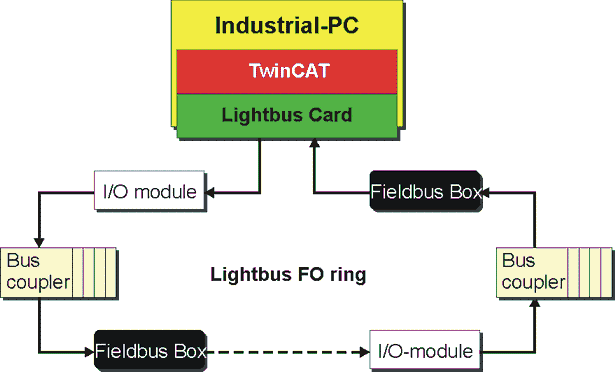Lightbus System Description
The Lightbus consists of the Lightbus PCI interface card (in short Lightbus card) and an optical fiber-based fieldbus.
The coupling of the Lightbus with the PC is realized on the Lightbus card via a Dual Ported RAM (DPRAM).
Various I/O modules (Bus Coupler, Bus Terminals, Fieldbus Boxes etc.) are available for input and output of the process images, which are connected through the Lightbus in a ring structure. The use of optical fibers results in low susceptibility to interference and a high transfer rate of 2.5 MBaud. Any errors occurring in the optical fiber ring are detected by the Lightbus card and reported to the PC. TwinCAT provides comprehensive diagnostic functions that support fast detection and correction of any errors.
A communication protocol that is optimized for speed and simplicity is specified for the data transfer between the Lightbus card and the I/O modules. The Lightbus card controls the communication on the optical fiber ring. It sends telegrams that pass through the I/O modules in the optical fiber ring and are then received and checked back at the Lightbus card.
A telegram consists of a telegram frame and the telegram content.
The telegram frame is required for serial data communication and consists of 1 start bit, 6 CRC check bits and 2 stop bits. It is generated and checked independently by the hardware of the Lightbus card. No software support is required.
The telegram content is essentially organized byte-wise. AD0 to AD7 form the address field, through which up to 254 I/O modules can be addressed (the addresses 0x00 and 0x0FF are reserved). The bits CR0 to CR3 specify the telegram type. The following functions can be specified in the telegram:
Functions
The bytes D0 to D3 contain the actual user data. The control field specifies the processing of these user data. The last byte in the telegram contains 6 bits for forming a CRC checksum and 2 reserved bits. A user data length of 50 bits thus achieves a hamming distance of d=3.
The Lightbus consists of a physical ring, which can be split into up to 8 logical rings for processing the process image. A logical ring only operates for selected I/O modules, which are specified via communication description lists (CDLs).
The Lightbus card makes the process image available to the PC via the DPRAM. The DPRAM is divided into three areas:
- ▪
- Data:
Input, output and flags
- ▪
- Communication:
Initialization, testing, analysis and configuration of the Beckhoff Lightbus
- ▪
- Process control:
Updating the Process Image
The DPRAM of the Lightbus cards requires 4 kB per channel in the address space of the PC.

